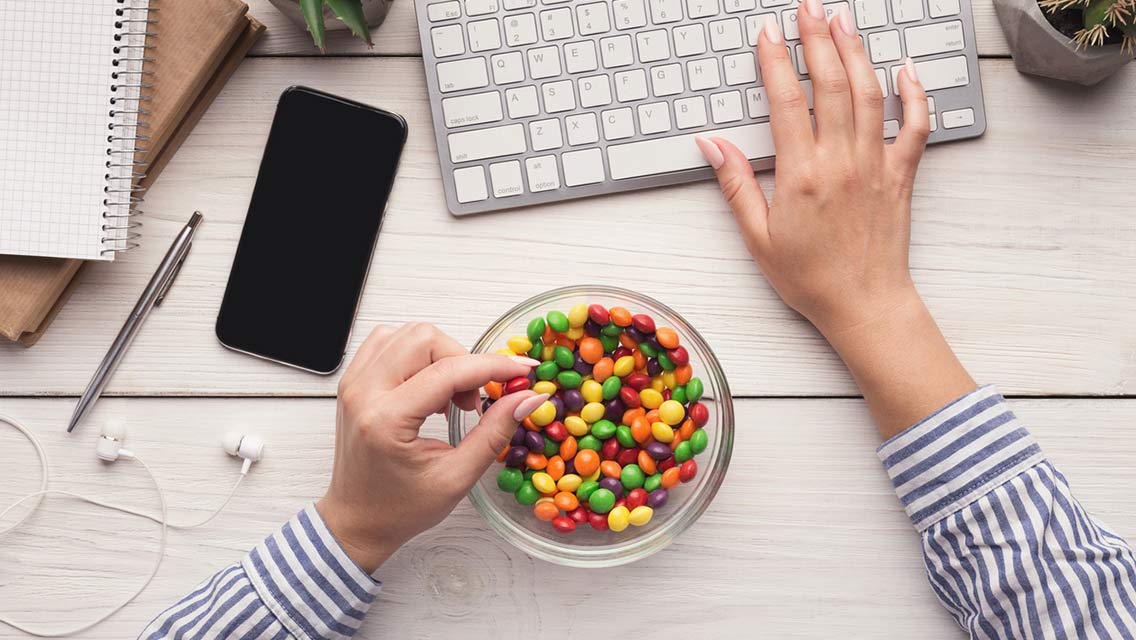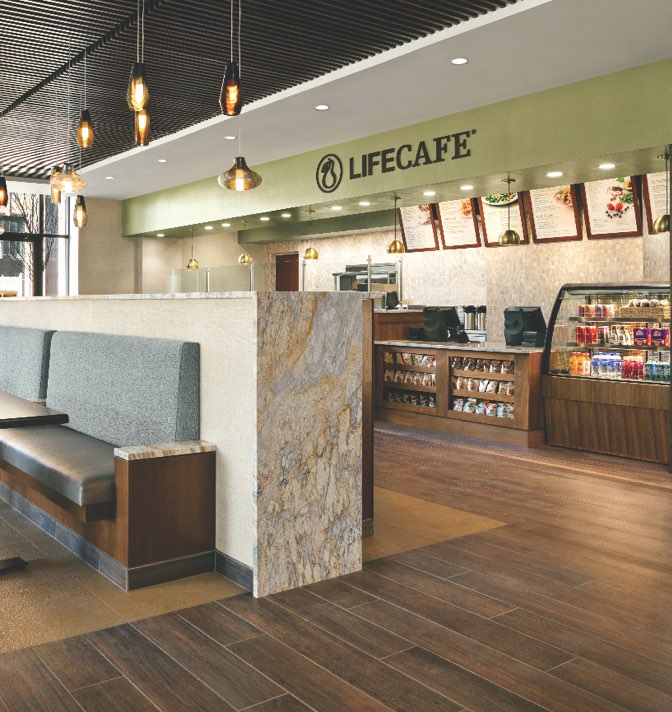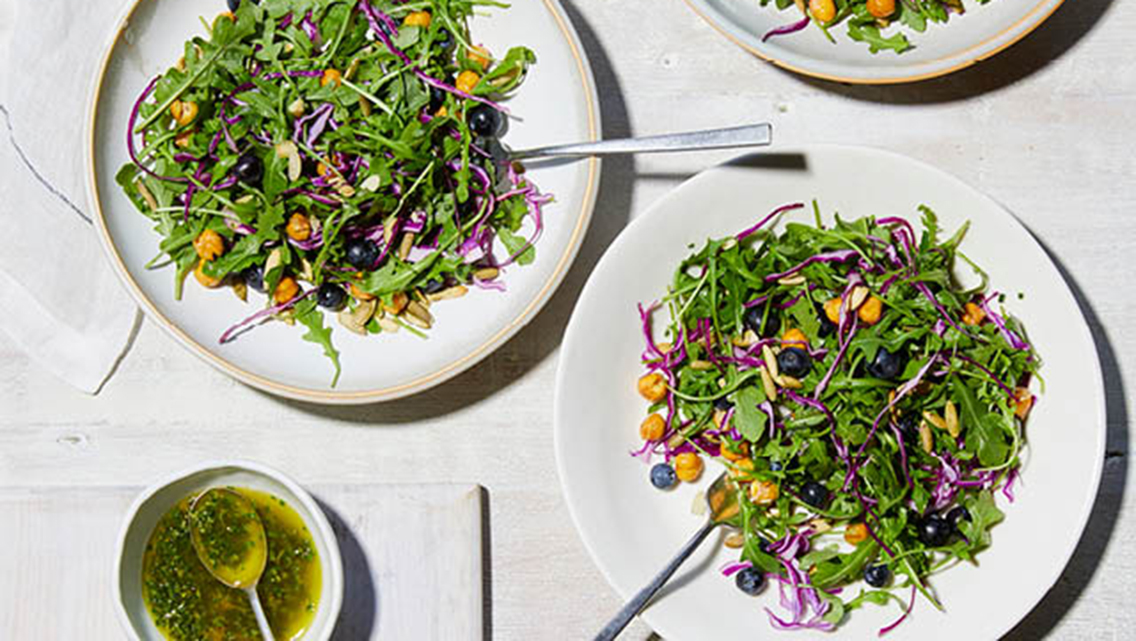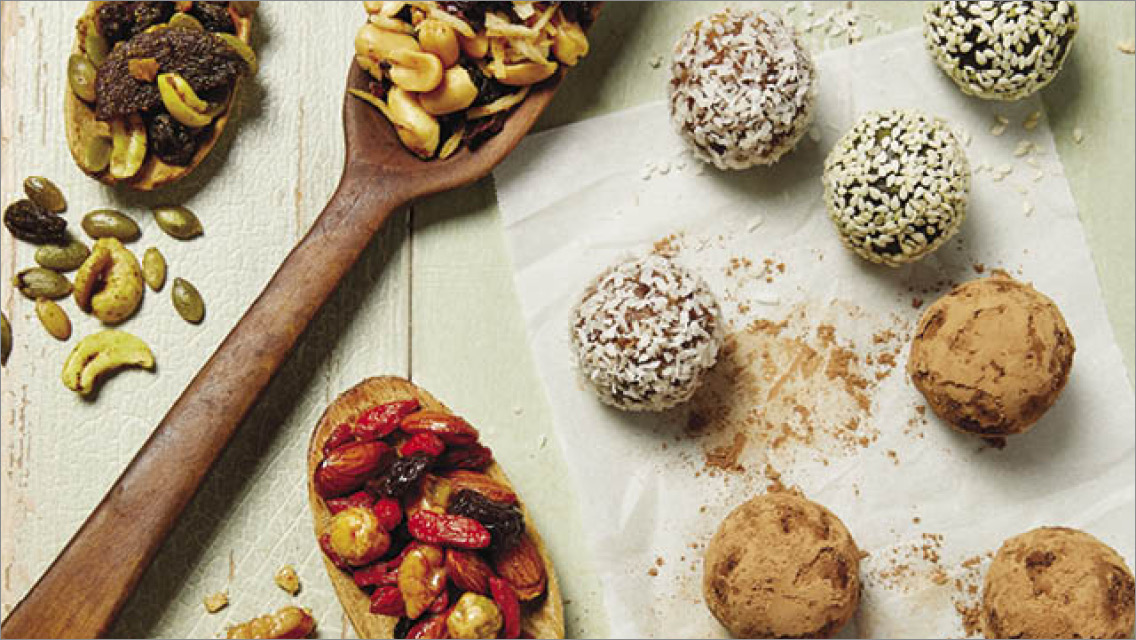During a typical workday, many of us navigate a veritable food minefield: Monday-morning doughnuts, afternoon trips to the vending machine, celebratory pizza parties, obligatory birthday cakes. Lunches catered in. Client dinners out. Food- and drink-laden business trips that leave you bursting at the seams.
From seal-the-deal steak dinners to bad banquet-table smorgasbords, a lot of busy professionals are faced with less-than-ideal choices about when and what they’re going to eat. Throw in a little job-related stress and deadline scheduling and you’ve got yourself the makings of a scale-tipping nutritional disaster.
“We’re a society that eats on the run, works long hours nonstop, skips meals and is time-pressured,” says Stephen Gullo, PhD, author of The Thin Commandments Diet. “We ‘make’ extra time by stealing it from eating time and exercise time. The workplace is loaded with unhealthy foods, because they’re quick and user-friendly. And temporarily, they make you feel satisfied.”
Hey, we know what you’re up against when it comes to eating at work. We also know that with a little forethought (and some awareness about social dynamics behind many workday food quandaries), it is possible to maintain, and even improve, your health and nutrition from 9 to 5. Making the choice to eat well will improve your personal fitness and emotional stability, too. To make it easier, we’ve outlined five common office food traps, along with strategies for outwitting them – right now, and for the long term.
1. Doughnuts on Tap
Your company prides itself on its benefit plans: health, dental and doughnuts. Look out, here comes the pastry cart.
A Quick Fix: Try to steer clear of the alluring baked-goods aroma, and grab some tea with a little milk and honey instead. It will satisfy your sweet tooth and give you something substantial to sip on while your coworkers are busy ingesting trans fats and mystery sprinkles. If you choose a high-quality tea or herbal tisane, the steamy brew will also fill your nose with an appealing (non-doughnut) fragrance.
You might also ask your company to provide fresh fruit as an additional, healthy option to the pastries. Thomson, formerly West, a publishing company in Eagan, Minn., did just that after rethinking the health implications of its twice-weekly free-doughnut tradition. “There isn’t a Tuesday or Thursday when I don’t cross paths with more than one person heading back from the cafeteria with two pieces of fruit in hand,” says Lance Odegard, a national technology manager at Thomson. “It promotes a healthier, more nutrition-conscious environment.”
A Long-Term Solution: Eat a healthy breakfast at home. It will make it easier to resist all those refined sugars and carbs that only make you hungrier at lunch.
Need more help? Try mentally reframing your food choices so they’re not about deprivation, advises life coach Ellen Shuman, founder and director of A Weigh Out, a life coaching network specializing in emotional-eating issues. Remember that choosing some fresh fruit, whole-grain flatbread or a hard-boiled egg instead of a doughnut’s highly processed, simple sugars is part of your positive commitment to a healthy lifestyle. “If you wake up every day saying you want your weight to be stable, but then you get into the baked goods at work, it creates emotional tension, which leads to more emotional eating,” Shuman says. “And that feels lousy.”
A Risk-Reduction Tip: Studies show that foods low on the glycemic index (proteins, complex carbs and whole grains) keep you satiated longer. They raise your blood-sugar levels more slowly and steadily than simple carbs, like doughnuts or fruit juice, which tend to create spike-and-crash reactions. One 2003 study showed that kids who ate sugary cereals like Coco Pops for breakfast ate more calories for lunch. We’re guessing that scenario might not be so different for grownups.
2. Power-Lunch Liabilities
You pack healthy midday meals, but then you keep getting invited out to big lunches with colleagues, contacts, even your boss. You want to expand your networking opportunities – but not your pants size.
A Quick Fix: Accept the invitations that count and start forcing liquids the moment you arrive at the restaurant table. Drink a glass of water, order a cup of tea or tomato juice (both are natural appetite suppressants), or start with a soup course. Push the breadbasket away and banish empty calories from your plate by being picky when ordering. Scan the menu for simply prepared items that contain grilled or steamed fish and vegetables.
If you’re ordering pasta, meat or another rich dish, see if they’ll bring you a half-order with a plate of mixed field greens or braised spinach on the side. Ask to have sauces served separately. Beware of giant entrée salads weighed down with cups of cheese and processed meat.
And whatever you order, set down your fork now and then. Listen to your body’s signals about your hunger level. And listen to your dining companions. After all, you’re there for the conversation, right?
A Long-Term Solution: Whenever possible, make dates only at restaurants where you know you can (and will) eat a healthy meal. And if you tend to be ravenous at 11 a.m. but have lunch appointments at 12:30 or 1 p.m., get into the habit of having a healthy office snack before your stomach starts growling (see “Love Your Lunch“). You’ll order more selectively, Gullo says, and you’ll be able to taste what you’re eating instead of wolfing it down without noticing its flavors and textures.
A Risk-Reduction Tip: Having a pre-meal snack and choosing a healthy venue become even more important if you’re going out for dinner, Gullo says. Dinner is a greater nutritional threat because, unlike at lunch, there’s no pressure to get back to the office. That opens up more time for appetizers and desserts.
Alcoholic drinks present another liability: They not only add calories, they can compromise your ability to judge how much and how well you’re eating (see Road-Food Woes, below). To minimize your exposure, limit yourself to a single glass of wine and keep your hand on your water glass as much as possible.
It can also help to stop midway through your meal to watch other people eating. This is a surprisingly effective appetite-blunter.
3. Road-Food Woes
After a 14-hour day of business travel, it’s time to treat yourself to an indulgent dinner on your business Visa card.
A Quick Fix: Order sushi. It’s low in calories, high in protein and complex carbohydrates, and it’s also a feast for the senses, so you won’t feel deprived.
Not a sushi fan?
Other seafood options abound, as do smaller cuts of high-quality lean meats (filet mignon, for example). But keep in mind that the whole concept of “food as reward” is a little misguided to begin with. What your body really needs when you’re traveling is some high-quality nutrition (to keep it going) and a good night’s rest (to help it recover).
Eating a rich, gigantic meal will put a big burden on your digestive system and may disrupt your sleep patterns. It will also flood your system with calories that no amount of tossing and turning is going to burn off.
So if you want to feel indulged, try an organic, raw-foods or exotic gourmet restaurant that specializes in high-quality ingredients. Then order a multicourse meal of smaller plates with fresh, delectable flavors.
A Long-Term Solution: Business travel presents some serious challenges to your health, and unless you get into the habit of eating well while on the road, you’ll probably end up paying the price in unwanted weight gain, compromised immunity and lowered vitality. So decide in advance of each departure that you’re going to rise to the challenge.
That’s what prompted holistic nutritionist and attorney Lisa Margolin, coauthor of ViVa’s Healthy Dining Guide, to put together a national directory of healthy eateries and markets. One of her favorite strategies: hitting ethnic restaurants with great soup selections. She favors brown rice and miso soup at Asian restaurants or black bean soup at Mexican restaurants. Margolin also travels with a snack bag of mixed nuts. “The slow breakdown of nutrients in the nuts helps keep your blood sugar balanced, and the healthy fats satisfy cravings,” she says.
A Risk-Reduction Tip: If you’re flying frequently and changing time zones, avoid bogging down your body with heavy meals. “After a few days of road food and a disrupted daily routine, travelers tend to feel rundown, and their digestive systems might not be working as well,” Margolin says.
Your immunity can suffer, too, which is the last thing you want when you’re being exposed to mobs of new people and bacteria. This is a great reason to eat for nutrition, not indulgence, while you’re on the road. Margolin also suggests taking an extra dose of vitamin C before you travel, staying hydrated with water, and avoiding carbonated or alcoholic beverages on the flight (for more tips, see “Road Warrior“).
4. Birthday Binges
At 3 p.m., a companywide email pops into your inbox: There’s cake in the conference room to celebrate Ruth’s birthday!
A Quick Fix: Get your priorities in order. Are you really interested in cake right now? Is a sugar, refined-flour and trans-fat infusion at 3 p.m. really in your best interest? Or is this more about you being ready for a break from your desk and wanting to be part of the festivities?
If your appetite has been stimulated by the mere mention of food, grab a healthy snack from your desk drawer before you head down the hall to wish Ruth well. If you’ve decided to partake, but want to keep your intake to a minimum, cut your own thin slice, take one nice, big bite (frosting and all, if that’s what floats your boat), then drop your plate in the trash so you can give Ruth a proper birthday hug. If you stay to socialize, try popping a piece of sugarless gum to reduce the temptation to seek seconds.
A Long-Term Solution: If your office mates seem to celebrate every occasion with a sheet cake, pizza party or platter of brownies, try starting a new potluck tradition and, suggests Gullo, make sure your offering is compatible with your meal plan.
A Risk-Reduction Tip: Start each day with a quick mental sketch of your food-intake intentions: Do you plan to eat healthy meals today? Will healthy snacks be available? Envision yourself eating healthily throughout the day, and know where your nutrition is coming from in advance. “If I plan mindfully, I decrease the chances I’m going to eat mindlessly,” says life coach Shuman.
If a gooey, 350-calorie brownie wasn’t in your food vision for the day, then keep that in perspective when unforeseen celebration temptations pop up. “The birthday boy or girl doesn’t give a damn whether you eat the cake,” Gullo points out. Given that, and your larger intentions for your health, what matters most to you?
5. Fending at the Vending Machine
While preparing a budget presentation, you realize you’re so ravenous you can’t concentrate. The vending machine – stocked with candy, chips and empty calories of all sorts – lurks in the break room.
A Quick Fix: Evaluate your options. Could this be an ideal time to take a quick, mind-clearing break and dash out for something healthier? Can you zip to a local market for a bag of tangerines that will last you into next week?
If you must eat from the vending machine, choose carefully. Most microwave popcorn is full of trans fats and sodium. Candies and cookies contain little besides sugar and refined flour. The crackers ‘n’ cheese options generally contain saturated fats, trans fats, refined flours, and lots of salt and sugar. Your best bets? Nuts or trail mix – but skip anything with “yogurt-covered” items (that coating is typically just a bad-fat-based sugar bath).
A Long-Term Solution: Set aside a drawer in your desk for good-for-you foods (dried fruits and nuts, vacuum-packed soymilk, whole-grain flatbread), and pack fresh snacks (apples, low-fat cheeses, yogurt) into your briefcase or tote each day, even if you don’t bring your lunch.
Speaking of lunch, be darned sure you make time for it. If you don’t, you’ll be vulnerable to what Gullo calls the “Wall Street Eating Syndrome” – putting off lunch until nearly 4 p.m. and then bingeing. Gullo suggests penciling your lunch and a late-afternoon snack into your daily calendar. Some companies offer healthy snacks (or at least space for them) in a breakroom refrigerator. If yours doesn’t, point out the benefits to your human resources team.
Ultimately, you are responsible for how well you eat. “The key is preparation,” says Elson Haas, MD, author of The Staying Healthy Shopper’s Guide. “Anyone can follow almost any diet if they prepare food ahead of time. While making dinner, I like to toss together lunch and snacks for work the next day.” (See the “Love Your Lunch“.)
A Risk-Reduction Tip: Even if you don’t feel particularly hungry, eat a small, healthy midafternoon snack anyway. In late afternoon, your blood sugar tends to drop, especially if you’ve skipped breakfast or lunch. This can leave you feeling sluggish, sleepy and unable to focus.
What’s worse, when you do eat late on an empty stomach, it can jump-start some undesirable chemical processes in your brain: A lurch in your insulin levels can encourage a release of the amino acid tryptophan. Once that tryptophan reaches the brain, it’s converted to serotonin, resulting in a blissed-out state that may encourage you to keep on eating – sending you right back to the vending machine for more.
The office candy dishes and doughnuts are unlikely to disappear overnight. The vending machines and power lunches may persist. But by becoming more conscious about the office food traps you face on a daily basis, you can do more than escape unwanted pounds – you can also reduce your stress, increase your productivity and improve your outlook. Feeling healthy and energetic on the job makes the hours you spend at work more rewarding. And that is sweet satisfaction indeed.
More Food Traps
6. Bad Meeting Blues
Your boss blames you for your coworker’s ineptitude, and you’re tempted to take solace in a Twinkie.
A Quick Fix: Get some fresh air instead. A few moments of walking and sky gazing can help you put things back in perspective and take the edge off any emotionally-provoked cravings. When you get back, yank out your journal, write any residual frustration in a few choice words, then end the passage with some self-congratulation: You didn’t add insult to injury by eating something that would have done you more harm than good, which makes the day a success!
A Long-Term Solution: Realize there’s a lot of science and habit going into that Twinkie craving — and that such cravings are rarely just isolated incidents. Rather, they are part of what Ellen Shuman, founder and director of A Weigh Out, calls “the doom loop” — an emotional eating cycle that takes more than willpower to interrupt.
Shuman coaches her clients with a four-step model. It leads from → unconscious negative behavior (Jane has a fight with her boss and finds herself in front of the vending machine eating candy) to → conscious negative behavior (Jane has a fight with her boss, thinks about candy though she knows it won’t help, but eats is anyway because she doesn’t know any other way to tolerate her feelings) to → conscious positive behavior (Jane has a fight with her boss and chooses to be mindful of what she’s thinking and feeling; she takes action based on her desired outcome and avoids her need to shutdown with candy). Ultimately, what every emotional eater would like to achieve is → unconscious positive behavior (Jane has a fight with her boss, but rather than automatically turning to food as comfort, she is now in touch with her thoughts and feelings, and she has developed many new strategies for tolerating uncomfortable feelings without using food.)
By developing your awareness about when you are triggered to eat by stress or anxiety, and by developing more constructive coping approaches, you not only reduce your exposure to “unplanned caloric events,” you also increase your confidence and self-esteem, making you less vulnerable to stresses of all kinds.
A Risk-Reduction Tip: Emotional eating can cross the line into disordered eating. If you sense you might be suffering from (or even vulnerable to) an eating disorder, seek the help of a professional who can help you break the cycle.
If you’ve simply gotten into the habit of food as a reward, seize the opportunity to shift into some healthier, more self-loving behaviors. “You have to develop an adult coping system,” says Stephen Gullo, author of The Thin Commandments Diet. You might treat yourself to a massage, listen to your favorite song, pick a card from a wisdom or affirmation deck, say a serenity prayer, or reach out to a friend or significant other who you can help you sort through your stressful situation in more productive way.
7. Conference Call Survival
You’re faced with hours in a conference room with nothing but candy and caffeine to keep you awake.
A Quick Fix: Hijack the water pitcher or grab a big mug of herbal tea. It’s harder to fall asleep with a full bladder — and frequent, short walks to the restroom will revive your energy.
A Long-term Solution: Arrive well-fed and pack along your own snacks. Or, while you’re at the breakfast buffet, grab an extra cup of yogurt and a banana for later. “Conference snack food is notoriously horrible,” says Lance Odegard, a national technology manager with Thomson. “But it can still be a big challenge to resist a table full of cookies if you have nothing better to snack on — particularly if everyone else is eating.” Ditto if that candy bowl is right in front of you.
A Risk-Reduction Tip: Start thinking less about caloric intake and more about your body chemistry. Those hard candies may seem innocuous enough at just 25 or so calories apiece, but the sugar can wreak havoc with your glycemic index and prompt a binge later. You might be better of with a 100 calories worth of protein-rich cheese.





This Post Has One Comment
Nice content and guide that everyone can refer through it. As much as possible healthy snacks must be put to vending machines particularly in office areas.